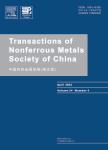Fatigue analysis of closed-cell aluminium foam using different material models
基于不同材料模型的闭孔泡沫铝疲劳分析作者机构:Faculty of Mechanical EngineeringUniversity of MariborSmetanova 172000 MariborSlovenia
出 版 物:《Transactions of Nonferrous Metals Society of China》 (中国有色金属学报(英文版))
年 卷 期:2021年第31卷第9期
页 面:2787-2796页
核心收录:
学科分类:08[工学] 0805[工学-材料科学与工程(可授工学、理学学位)] 080502[工学-材料学] 0703[理学-化学] 0702[理学-物理学]
基 金:The authors would like to thank the Ministry of Education Science and Sport of the Republic of Slovenia for financial support(Research Core Funding No.P2-0063)
主 题:closed-cell aluminium foams fatigue numerical analysis material model
摘 要:The fatigue analyses of AlSi7 closed-cell aluminium foam were performed using a real porous model and three different homogenised material models:crushable foam model,isotropic hardening model and kinematic hardening *** numerical analysis using all three homogenised material models is based on the available experimental results previously determined from fatigue tests under oscillating tensile loading with the stress ratio R=*** obtained computational results have shown that both isotropic and kinematic hardening models are suitable to analyse the fatigue behaviour of closed-cell aluminium ***,the kinematic hardening material model has demonstrated significantly shorter simulation time if compared to the isotropic hardening material *** the other hand,the crushable foam model is recognized as an inappropriate approach for the fatigue analyses under tension loading conditions.



